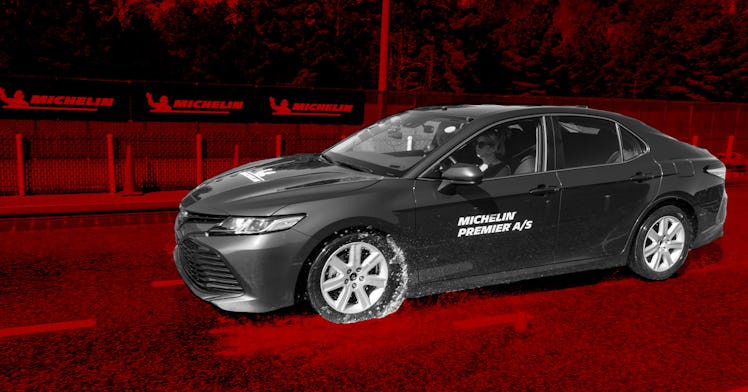The Car Safety Issue Far Too Many Parents Ignore
Your car seat is on lock, sure, but what about your tires?

This story was produced in partnership with Michelin North America, Inc.
It’s a sunny spring day at the 3,500-acre Laurens Proving Grounds in South Carolina, where Michelin has been testing tires since 1976. The cruise control is set at 45 mph, which feels pretty fast when you’re barreling between traffic cones down a test track with sprinklers dousing the asphalt, waiting for the signal to hit the brakes. I’m not on Michelin tires for this run, but those of a close competitor. Both this and the Michelin sets I was recently driving on are buffed-down nearly to the end of their lifespan.
“Brake!” cries the instructor in the passenger seat, as the front bumper reaches a yellow flag marker at the side of the track.
I put my full weight on the pedal, the ABS stutters into action, and I expect the car to stop where it had on the previous run — even my reflexes were expecting it — but instead I just keep going. And at the spot where the car fitted with Michelin tires had come to dead stop, I am still going 18 mph — a speed at which a collision with anything is still a dangerous accident.
“Feel the difference?” asks the instructor.
I feel it, I see it, and I won’t soon forget it.
When we think of child safety in a car, we think about car seats, often to the point of obsession. We install them in our cars with great care, staring at the level with a surveyor’s precision, and yanking the base back and forth to make sure it’s as tight as it can be. The car seat absorbs a tremendous amount of parental obsession, and rightly so. But most of us overlook the fact that one of the most fundamental child safety devices isn’t in the car at all: It is the set of tires your car is riding on.
When you drive, the actual portion of each tire in contact with the road at any given time is an area about the size of your hand. So, you’re driving around a few thousand pounds of vehicle with four hands touching the road. Now add a deluge of rain, and you have to trust those four hands to stay in contact with the road. As tires wear out and treads get increasingly shallow, those four hands struggle to continue safely channeling off water. This means when you take a corner in the rain, you’re more likely to lose control. If you need to make a sudden stop, even if your brakes do their job perfectly, your tires will not.
We are all driving on worn tires, to varying degrees. So, the question we should ask ourselves as parents is not just how safe our tires are when they’re brand-new, but how safe they are down the stretch. A tire needs grooves and biting edges to channel water away, and both of these tread elements wear away in time with most tires. The MICHELIN® Premier® A/S tires have gone all in on late-life performance, by embedding the tire with hidden treads that reveal themselves over time, to give them a late-life renaissance of sorts. When the tires are brand new they have horizontal treads that look like laser-cut lines, but these gradually widen to become the biting edges of the tires in their golden years. And the vertical grooves also widen with time, in order to maintain safety in inclement weather over the lifespan of the tire.
Most tire companies make tires to perform well when they’re new, because it’s simpler to make them that way: it’s easier to pull a tire out of a mold if it has a more straightforward tread pattern. In essence, they turn their manufacturing expediency into a problem for the consumer down the road, rather than taking on the greater cost and effort needed to make a tire that will keep doing its job throughout its life.
In practice, this means older Michelin tires that hold corners in the rain, and that stop you and your precious cargo while other tires are still going 18 mph. There is something deeply jarring about a product we rely on every day not doing what it’s supposed to. You count on your shower to be hot when you turn the knob; you count on your lights to come on when you flip the switch; and you expect your tires to stop when you slam on the brakes. When these things don’t happen, it can feel like the modern world itself has betrayed you, even when the truth is something simple, like you blew a fuse, or you bought the wrong set of tires.
We buy convertible car seats because they can grow with your child and keep them safe for years to come — from infant, to back-facing, to forward-facing. Similarly, Michelin has made a tire that automatically adjusts for the future. Maybe it’s time for us fathers to adjust accordingly.